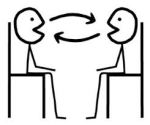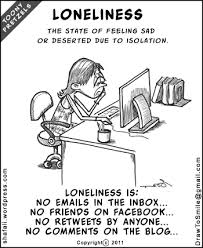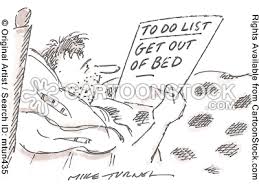
By Bob Aronson
The very first thing you should know is that depression is common after an organ transplant – very common and no one is immune. You should also know that there is help available. You don’t have to feel that way! I know because I suffer from it. As of this writing I am six years post transplant and my depression is under control because I found help but it still rears its ugly head from time to time.
For two years following my 2007 heart transplant I wallowed in emotional pain, I felt useless, worthless, without value, guilty and empty. I looked at myself as one might look at a car you’ve owned for many years. It was useful and desirable once but now it is old and things keep going wrong and need fixing. To keep it running just costs too much and sad as it is we are probably better off without it. It is costing more than it is worth. That’s pretty much how I felt about myself.
Depression, I think, is compounded by the patient’s inner battle between the armies of logical thought and those of emotion. Your logical mind asks, “How can you be depressed when you just got a new heart that saved your life?” But, your emotions say, “I don’t know but I feel awful and sometimes I wish I was dead.” That is a horrible battle to have to fight alone…but you don’t have to, there’s help and you can win.
For a quarter of a century  I had been a communications consultant with a stable of highly respected internationally known clients many of which were based in Minnesota where I lived. I needed a heart transplant and discovered that I stood a better chance of getting one if I moved to Jacksonville, Florida. I learned that the Mayo Clinic there had an excellent record of obtaining and transplanting organs and data indicated I stood a better chance of getting a heart there than in Minnesota. Furthermore, Jacksonville was my wife Robin’s home town and her son, parents and extended family lived there. It made sense to move…but it also meant giving up a lion’s share of my business.
I had been a communications consultant with a stable of highly respected internationally known clients many of which were based in Minnesota where I lived. I needed a heart transplant and discovered that I stood a better chance of getting one if I moved to Jacksonville, Florida. I learned that the Mayo Clinic there had an excellent record of obtaining and transplanting organs and data indicated I stood a better chance of getting a heart there than in Minnesota. Furthermore, Jacksonville was my wife Robin’s home town and her son, parents and extended family lived there. It made sense to move…but it also meant giving up a lion’s share of my business.
To shorten a long story we moved to Jacksonville and I got my new heart after only a 13 day wait but recovery took longer than expected. There were complications…many of them. I got pneumonia, suffered two torn rotator cuffs which resulted in an extended period of excruciating pain and I became very, very depressed. I could hardly function day to day never mind think of working again. But, because I could not work I felt guilty and my depression got worse.
I sat in a dark corner of our family room every day watching the TV’s flickering light change the shadows in the room. The set was on but rarely was I involved in what was playing…my mind was somewhere else. I felt totally and utterly useless and guilty that I had taken an organ but couldn’t do anything to show that I was worthy of it. I felt that way for two years. Each day I went through the motions of living, trying to be useful, trying to help my wife with her fledgling business but feeling totally inadequate and unnecessary.
You’ve seen the Roadrunner TV cartoon I’m sure where the poor coyote just can’t win against his fleet footed foe.  Often the canine victim is seen hanging by one hand from a branch on the side of a mountain…then the branch gives way and he falls the 5,000 feet to the ground below which flattens him. I felt like Wylie, like I was hanging from that branch waiting to fall and sometimes I wished the branch would break.
Often the canine victim is seen hanging by one hand from a branch on the side of a mountain…then the branch gives way and he falls the 5,000 feet to the ground below which flattens him. I felt like Wylie, like I was hanging from that branch waiting to fall and sometimes I wished the branch would break.
Two things kept me from giving up, Robin’s constant encouragement and this blog along with my Facebook Group Organ Transplant Initiative (OTI). Both were started two months after my transplant at the urging of my friends at Mayo. These social media activities weren’t meant to be anti depressants but they turned out to be just that. Thank God for both of them.
Then, one day, it occurred to me that maybe, just maybe I could get help and for the first time I mentioned depression as a problem to my Mayo Clinic transplant coordinator. With virtually no delay I was seen by a physician who determined that anti depressants might help. There were several false starts before we found one that worked but we did
At about the same time Robin asked me if I could make some wood fixtures for her art show booth; shelving, pedestals and other display items. I soon found I loved woodwork and a new hobby was born, one that ensured my not returning to that dark corner in which I used to reside.
As I did the research for this blog I found a good deal of information about depression, most of it clinical in nature and not real helpful. From personal experience I know that fighting depression isn’t easy. I know that it can last a long time, it can take even more time to find the right solution and sometime the solutions have a short life and the depression returns which forces you to find another solution. It is a never ending battle but oh so worth it.
In a document titled “Issues for Today’s transplant Patients….A guide” published by the National Kidney Foundation (NKF) http://www.kidney.org/transplantation/transAction/pdf/UnderstandingDepression.pdf there is an excellent section on post transplant depression, “Understanding Depression” I won’t re-print all of it but here’s some of it.

Depression is extremely common in the United States, and it can have a unique impact on transplant recipients. Practically every transplant recipient has likely felt—or fought off—depression at some time or another.
Living with a new organ has daily challenges. These include medical bills and getting used to a new body. Some transplant recipients may also feel they are burdening their loved ones with constant doctors’ visits and a general need for extra help. All of this comes on top of the trials and tribulations that arise for everyone, transplant recipient or not.
It’s normal to have a range of feelings after a transplant. We at the NKF believe that depression is one of the biggest issues people face, and something a lot of health care workers ignore. Research shows that, in any given year, almost 10 percent of theU.S. population is depressed. That’s 19 million adults, with and without transplants. And in people with chronic illness, the incidence of depression is much higher . Some research suggests that up to 25 percent of people with illnesses become depressed at some point in their lives. So, if you are a transplant recipient and you feel depressed, you are definitely not alone.
Depression is different. It’s not just a bad mood, which is something everybody feels. Being depressed means that people feel at least five symptoms of depression for two weeks or longer. A bad mood should only last a couple of days. Depression is also more intense than a bad mood, even how the body feels.
Nine symptoms of depression:
- Feeling depressed for most of the day, almost every day
- Lack of enjoyment of activities you once enjoyed, such as going to work or visiting friends.
- Weight changes (gaining or losing).
- Sleep problems (too much or too little).
- Feeling restless.
- Lacking energy, feeling easily fatigued.
- Feeling worthless or guilty.
- Trouble concentrating.
- Frequent thoughts of suicide.
Remember that people have to have at least five of these nine symptoms for at least two weeks before doctors will diagnose depression. This is to make sure that people who have bad days here and there are not misdiagnosed.
The stress of having a transplant can trigger depression. Having a transplant is a life-altering experience. The range of emotions people feel as a result of the procedure can definitely trigger depression in those who are susceptible to it. It can be incredibly difficult for people to accept that one of the organs they were born with no longer works. For many, organ failure can feel like a profound loss. Some really grieve over it, which is totally under-standable. Unfortunately, this grief can also lead to depression.
Having a transplant can create another loss, by changing recipients’ lives in an irreversible way. They may grieve that they can no longer lead the same life as before, now having to rely on doctors and medications to stay well. That can be hard to accept.
Some recipients may also find it hard to accept that they are more dependent on their families. They may feel like their illness disrupts their families’ lives, and they are dependent on them emotionally and sometimes financially.
For recipients who are used to being the sole providers for their families, that can be really tough. Financially, many transplant recipients also worry about their futures and how to afford the medicines they’ll need for the rest of their lives. People with kidney transplants often worry about their health insurance, knowing that they lose Medicare after three years.
Ok, all of that explanation makes a lot of sense but if you are depressed what can you do about it? There’s much that can be done and you can start by talking to your transplant coordinator. You can be sure they’ll have some resources for you to investigate or they can arrange for you for appointments.
While treatments abound there are two that are most common. They are talk therapy and medication. The most common type of therapy cognitive behavior therapy, or CBT. A highly skilled therapist can help you correct the negative thought patterns behind your depression. For instance, if people are constantly feeling hopeless, or that there’s no point in living, There is also a behavioral aspect to cognitive behavior therapy. It focuses on how helping you avoid behaviors that cause or invite depression…behaviors like staying in bed all day or avoiding activities that had been enjoyable. This kind of therapy can be done in a one on one or group setting, whichever makes you more comfortable and is most effective.
Another form of therapy is medication. Sometimes both therapies are applied simultaneously but experts in depression can advise you best on when that is appropriate.
In my case it was medication that worked. But it took time, there were months of trial and error. It usually takes four to six weeks for an anti depression medication to work. Sometimes it did but only for a short while and on other occasions there was no effect at all and we’d have to start all over again. Different people react differently to the same medication. What may work for your neighbor may not work for you at all but withy patience and the aid of a professional it is likely you will find the right one.
A word of caution: AVOID ST. JOHN’S WORT

A lot of people use herbal medicines to treat a variety of conditions. One very popular herbal medicine is St. John’s Wort which has achieved some popularity in treating depression. Transplant patients should avoid using it because medical evidence clearly indicates that St. John’s Wort interferes with other drugs like Cyclosporin, which people take to prevent transplant rejection. There is documented evidence that some transplant recipients have lost their organs after taking St. John’s Wort.
Still another way to address depression is activity, a hobby, a business, a project. The combination of medication and activity is what got me out of depression and keeps me there. I rarely sit still and when I do it’s because I’m exhausted from all the activity. I will be writing more about activities but woodwork, music, art, nature studies or astronomy can be of immense help in chasing away your demons. There’s one for you…you just have to find it.
One way of beating depression is…not to get it. Not long ago CBS TV news did an interesting story on the subject called, “Depression: Ten Traps to Avoid” You can watch it on this link…or read it below.
http://www.cbsnews.com/2300-204_162-10004447.html
Clinical depression is a devastating illness, and profound sadness is just the beginning. Depression can rob people of their energy, memory, concentration, sex drive, interest in usual activities – and in severe cases, even the will to live. Seventy million Americans will be afflicted at some point.
Dr. Stephen Ilardi, author of “The Depression Cure,” has identified several things that can make depression worse.
Depression is a serious medical condition and should be treated by a doctor or licensed therapist.
Trap 1: Being a Couch Potato

When you’re feeling down, it’s tempting to hole up in your bed or on the couch. Yet exercise –
Even moderate activity like brisk walking – has been shown to be at least as effective against depression as antidepressant medication. It works by boosting the activity of the “feel-good” neurochemicals dopamine and serotonin.
For an “antidepressant dose” of exercise, try at least 40 minutes of brisk walking or other aerobic activity three times a week.
Trap 2: Not Eating “Brain Food”

Omega-3 fats are key building blocks of brain tissue. But the body can’t make omega-3s; they have to come from our diets. Unfortunately, most Americans don’t consume nearly enough Omega-3s, and a deficiency leaves the brain vulnerable to depression. Omega-3s are found in wild game, cold-water fish and other seafood, but the most convenient source is a fish oil supplement. Ask your doctor about taking a daily dose of 1,000 mg of EPA, the most anti-inflammatory form of omega-3.
Trap 3: Avoiding Sunlight

Sunlight exposure is a natural mood booster. It triggers the brain’s production of serotonin, decreasing anxiety and giving a sense of well-being. Sunlight also helps reset the body clock each day, keeping sleep and other biological rhythms in sync.
During the short, cold, cloudy days of winter, an artificial light box can substitute effectively for missing sunlight. In fact, 30 minutes in front of a bright light box each day can help drive away the winter blues.
Trap 4: Not Getting Enough Vitamin D

Most people know vitamin D is needed to build strong bones. But it’s also essential for brain health. Unfortunately, more than 80 percent of Americans are vitamin D deficient. From March through October, midday sunlight exposure stimulates vitamin D production in the skin – experts advise five to 15 minutes of daily exposure (without sunscreen). For the rest of the year, ask your doctor about taking a vitamin D supplement.
Trap 5: Having Poor Sleep Habits

Chronic sleep deprivation is a major trigger of clinical depression, and many Americans fail to get the recommended seven to eight hours a night. How can you get better sleep?
Use the bed only for sleep and sex – not for watching TV, reading, or using a laptop. Turn in for bed and get up at the same time each day. Avoid caffeine and other stimulants after midday. Finally, turn off all overhead lights
Trap 6: Avoiding Friends and Family

When life becomes stressful, people often cut themselves off from others. That’s exactly the wrong thing to do, as research has shown that contact with supportive friends and family members can dramatically cut the risk of depression. Proximity to those who care about us actually changes our brain chemistry, slamming the brakes on the brain’s runaway stress circuits.
Trap 7: Mulling Things Over

When we’re depressed or anxious, we’re prone to dwelling at length on negative thoughts – rehashing themes of rejection, loss, failure, and threat, often for hours on end. Such rumination on negative thoughts is a major trigger for depression – and taking steps to avoid rumination has proven to be highly effective against depression.
How can you avoid rumination? Redirect attention away from your thoughts and toward interaction with others, or shift your focus to an absorbing activity. Alternatively, spend 10 minutes writing down the troubling thoughts, as a prelude to walking away from them.
Trap 8: Running with the Wrong Crowd

Scientists have discovered that moods are highly contagious: we “catch” them from the people around us, the result of specialized mirror neurons in the brain. If you’re feeling blue, spending time with upbeat, optimistic people might help you “light up” your brain’s positive emotion circuits.
Trap 9: Eating Sugar and Simple Carbs

Researchers now know that a depressed brain is an inflamed brain. And what we eat largely determines our level of inflammation. Sugar and simple carbs are highly inflammatory: they’re best consumed sparingly, if at all.
In contrast, colorful fruits and veggies are chockablock with natural antioxidants.  Eating them can protect the body’s omega-3s, providing yet another nice antidepressant boost.
Eating them can protect the body’s omega-3s, providing yet another nice antidepressant boost.
Trap 10: Failing to Get Help

Depression can be a life-threatening illness, and it’s not one you should try to “tough out” or battle on your own. People experiencing depression can benefit from the guidance of a trained behavior therapist to help them put into action depression-fighting strategies like exercise, sunlight exposure, omega-3 supplementation, anti-ruminative activity, enhanced social connection, and healthy sleep habits.
We hope this blog has helped. If you feel depressed or even if you are not sure talk to your transplant coordinator or any mental health professional. There is help. You don’t have to feel the way you do.

Bob Aronson of Bob’s Newheart is a 2007 heart transplant recipient, the founder of Facebook’s nearly 3,000 member Organ Transplant Initiative and the author of most of these donation/transplantation blogs.
You may comment in the space provided or email your thoughts to me at bob@baronson.org. And – please spread the word about the immediate need for more organ donors. There is nothing you can do that is of greater importance. If you convince one person to be an organ and tissue donor you may save or positively affect over 60 lives. Some of those lives may be people you know and love.
Please view our music video “Dawn Anita The Gift of Life” on YouTube https://www.youtube.com/watch?v=eYFFJoHJwHs. This video is free to anyone who wants to use it and no permission is needed.
If you want to spread the word personally about organ donation, we have another PowerPoint slide show for your use free and without permission. JAgain, write to me and ask for “Life Pass It On.” I will email it to you immediately. This is NOT a stand-alone show; it needs a presenter but is professionally produced and factually sound. If you decide to use the show I will also send you a free copy of my e-book, “How to Get a Standing “O” that will help you with presentation skills. Just write to bob@baronson.org and I will send the show and book ASAP.
Also…there is more information on this blog site about other donation/transplantation issues. Additionally we would love to have you join our Facebook group, Organ Transplant Initiative (OTI). The more members we get the greater our clout with decision makers.
En Espanol
Bob Aronson de Newheart de Bob es un centro receptor de trasplante 2007, el fundador de la Iniciativa de Facebook cerca de 3.000 miembros de trasplantes de órganos y el autor de la mayoría de estos blogs de donación / trasplante.
Usted puede dejar un comentario en el espacio proporcionado o por correo electrónico a sus pensamientos a mí en bob@baronson.org. Y – por favor difundir la palabra acerca de la necesidad inmediata de más donantes de órganos. No hay nada que puedas hacer lo que es de mayor importancia. Si se convence a una persona para ser un donante de órganos y tejidos puede salvar o positivamente afectará a más de 60 vidas. Algunas de esas vidas puede haber gente que conoces y amas.
Por favor, vea nuestro video musical “Dawn Anita The Gift of Life” en YouTube https://www.youtube.com/watch?v=eYFFJoHJwHs. Este video es libre para cualquier persona que quiera usarlo y no se necesita permiso.
Si quieres correr la voz personal sobre la donación de órganos, tenemos otra presentación de PowerPoint para su uso gratuito y sin permiso. JAgain, escribir a mí y pedir “Life Pass It On.” Voy a enviar por correo electrónico a usted inmediatamente Esto no es un espectáculo independiente,. Necesita un presentador, pero es producido profesionalmente y objetivamente sonido Si usted decide utilizar el archivo. demuestro que también le enviará una copia gratuita de mi libro electrónico, “Cómo obtener un Standing” O “que le ayudará con habilidades de presentación. Sólo escribo bob@baronson.org y enviaré el programa y el libro lo antes posible.
Además … hay más información sobre este sitio de blogs de otros temas de donación / trasplante. Además, nos encantaría que te unas a nuestro grupo de Facebook, la Iniciativa de Trasplante de Órganos (OTI). Cuantos más miembros que tienen la mayor influencia en nuestra toma de decisiones.




 You would think apologies should be done in person. But that is not always the best or most practical approach.
You would think apologies should be done in person. But that is not always the best or most practical approach.

 you can choose what to include and hope for the best. However, if your goal is to repair and restore a damaged relationship, then you should heed the approach that works most successfully in a larger world.
you can choose what to include and hope for the best. However, if your goal is to repair and restore a damaged relationship, then you should heed the approach that works most successfully in a larger world. move on with your life?
move on with your life?
 As human beings, we will find ourselves guilty more than once of causing temporary distress in other people’s lives. Learning how to repair the damage that distress can cause necessarily involves utilizing effective apologies. That is a part of actively becoming a better person. That kind of growth is possible and desirable as long as we live.
As human beings, we will find ourselves guilty more than once of causing temporary distress in other people’s lives. Learning how to repair the damage that distress can cause necessarily involves utilizing effective apologies. That is a part of actively becoming a better person. That kind of growth is possible and desirable as long as we live. n award winning high school speech and English teacher, Priscilla Diffie-Couch went on to get her ED.D. from Oklahoma State University, where she taught speech followed by two years with the faculty of communication at the University of Tulsa. In her consulting business later in Dallas, she designed and conducted seminars in organizational and group communication.
n award winning high school speech and English teacher, Priscilla Diffie-Couch went on to get her ED.D. from Oklahoma State University, where she taught speech followed by two years with the faculty of communication at the University of Tulsa. In her consulting business later in Dallas, she designed and conducted seminars in organizational and group communication. Bob Aronson of Bob’s Newheart is a 2007 heart transplant recipient, the founder of Facebook’s over 4,000 member Organ Transplant Initiative (OTI) and the author of most of these donation/transplantation blogs. You may comment in the space provided or email your thoughts to me at bob@baronson.org. And – please spread the word about the immediate need for more organ donors. There is nothing you can do that is of greater importance. If you convince one person to be an organ and tissue donor you may save or positively affect over 60 lives. Some of those lives may be people you know and love.
Bob Aronson of Bob’s Newheart is a 2007 heart transplant recipient, the founder of Facebook’s over 4,000 member Organ Transplant Initiative (OTI) and the author of most of these donation/transplantation blogs. You may comment in the space provided or email your thoughts to me at bob@baronson.org. And – please spread the word about the immediate need for more organ donors. There is nothing you can do that is of greater importance. If you convince one person to be an organ and tissue donor you may save or positively affect over 60 lives. Some of those lives may be people you know and love.






































You must be logged in to post a comment.